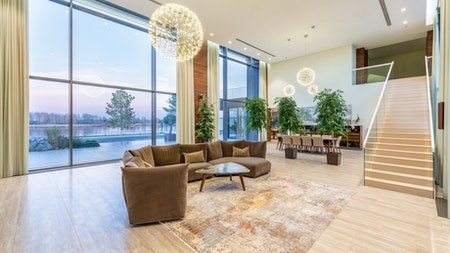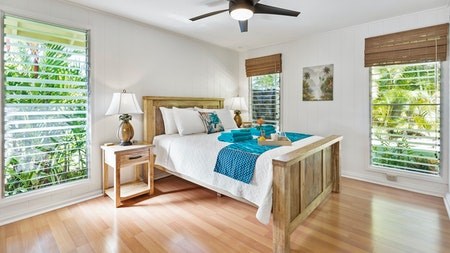Although windows and natural light are important factors in the design of a home, window coverings are often treated as an afterthought in the decorating process.
Window coverings can be functional, purely decorative, or strike a balance between the two - depending on your space and the amount of natural light you receive and prefer.
Curtains
Curtains are classic decorative and functional window treatments and have a long history in interior décor. But they are by no means outdated. Curtains are multifunctional, versatile, affordable, and efficient in keeping up with modern design trends.
Advantages include:
Decorative. Curtains can change the feel and appearance of a room and blend well with any theme or decorative style.
Altering room size appearance. To make a room look smaller, hang curtains in strong colours that contrast with walls. Curtains in a heavier fabric will also create a cosy atmosphere that large rooms lack. To make a room appear bigger, hang curtains in a colour similar to the walls.
Added privacy. Closing the curtains shuts out neighbours and passersby.
Excellent insulation. Their fabric layer properties reduce heat gain and loss in a room, so curtains are more effective than most window blinds in controlling room temperature.
Control the flow of natural light. Curtains can block all the light or allow in natural light as preferred.
Noise buffer. Curtains can muffle sound as carpets do. They also improve the quality of sound and reduce vibrations in a room. This is why curtains are often used against walls in home cinemas.
Versatility. Curtains can easily accommodate large or oddly-shaped windows. They come in a variety of materials, designs, and styles to match most home décor fashion requirements.
Affordability. Ready-made curtains are among the least expensive window covering options.
Convenience. Curtains are convenient to install or replace when needed and require little maintenance. They are easier to clean and replace than blinds, shades or shutters.
Blinds
Blinds can be made of fabric, plastic, wood, or metal. The most commonly fitted are vertical blinds and Venetian blinds, and other types include Japanese blinds, pleated blinds and cellular blinds.
- Vertical blinds have vertical slats attached to a rail fitted to the inside of the window reveal or above the window outside the reveal. The slats move from side to side to admit or exclude light, by means of a control wand to one side of the window space.
- Venetian blinds have horizontal slats that can be tilted up or down using a control wand. They can also be pulled up to be out of sight at the top of the window.
- Japanese roller blinds are often used to shade large areas or as dividers for indoor spaces.
- Pleated blinds are made from a pleated fabric that pulls up to sit flat at the top of a window, and are out of sight when open.
Shades
Shades are similar to blinds. But instead of using slats, they consist of a single piece of soft fabric. The fabric can be stacked, folded or rolled to open or close the shade.
- Roman shades are made from fabric that pleats as it is raised. Mounting slats connected to cords are attached to the back of a fabric panel. When the blind is lifted, the cords pull the slats together and force the blind to fold into pleats.
- Cellular shades are similar to pleated blinds except that they consist of two or more layers joined at the pleats to form cellular compartments. These compartments trap air, providing insulation. Because of this, cellular shades are probably the most energy-efficient and sound-absorbent window treatment available.
Shutters
Shutters are usually installed in the window reveal. They consist of horizontal slats made of wood or synthetic materials. The slats can be stationary or adjustable to allow or prevent light and air into a room.
Shutters can be installed indoors or outside on a window or a sliding door. They are often fitted as an additional security measure, particularly in lock-up-and-go homes where the owners may be away for lengthy periods.
Full attention
Whether your tastes run to full and flowing drapes, modern coverings, classic curtains, Roman shades, or laidback shutters – your windows deserve your full attention.





